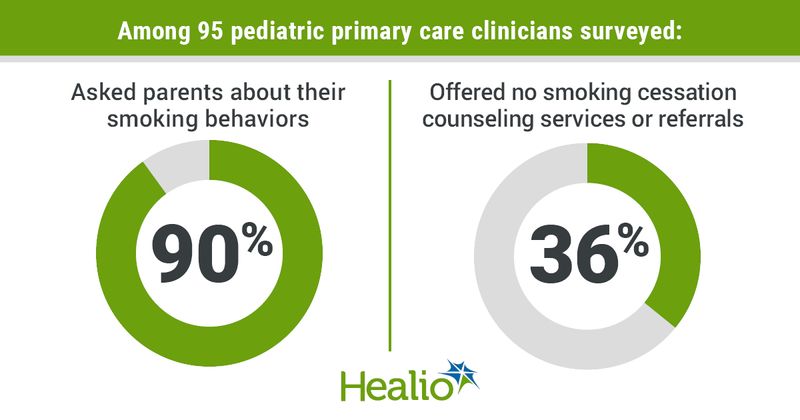Most pediatric clinicians do not provide smoking cessation counseling to parents
Pediatric primary care clinicians “frequently” screened parents to obtain their smoking behaviors but “rarely” provided smoking cessation counseling, researchers wrote in PLoS One.
“Our [pediatric] patients are often affected by the decisions and choices of their parents, making it important that we provide education, resources and support to the parents,” Tregony Simoneau, MD, a pediatric pulmonologist at Boston Children’s Hospital, told Healio Primary Care. “In order to do this well, we need to understand the needs of the parents.”

In addition, although pediatric primary care clinicians acknowledged the dangers of e-cigarettes, Simoneau and colleagues reported that they “infrequently” provided youth with information about these dangers.

The researchers surveyed a convenience sample of 1,549 families and 95 clinicians throughout Connecticut to learn more about smoking habits, trends in screening, cessation counseling practices and efforts to educate parents and youth about the health risks tied to smoking. Thirty-four clinicians who responded to the survey also participated in one of three focus groups that explored smoking and vaping counseling practices.
After tabulating responses, Simoneau and colleagues reported that 21% of parents said there was at least one smoker in their household. Most parents (71%), regardless of smoking amount, smoking duration or whether they resided in an urban or rural area, expressed interest in the smoker quitting.
Among the clinicians:
- 90% asked parents about their smoking behaviors at least once a year, but 36% did not offer smoking cessation counseling services or referrals;
- 99% advised youth about the risks associated with nicotine and tobacco use, but most clinicians “reported low self-efficacy” regarding smoking cessation and prevention counseling in parents and youth; and
- 93% said e-cigarettes were “equally or more dangerous than cigarettes,” yet 34% never discussed the dangers of e-cigarette use with minors.
“At the time that this survey was done, vaping was really quite new, and we didn’t know as much about its dangers and risks,” Simoneau said. “It has really only been in the last year or 2 that we have learned more about [e-cigarette or] vaping‐related lung injury, or EVALI, and now we are more prepared to speak to the risks.”
According to the researchers, the clinicians who were part of the focus groups said a lack of time kept them from making smoking cessation discussions a “priority” during well-child visits and that discussions about drugs, gun violence and sex were more important.
Simoneau noted that family practices where parents are also patients might see different results from a duplicate study. She stressed the need for primary care providers to “have easily accessible resources to learn about the dangers of electronic cigarettes.”
“The AAP is an excellent resource for finding key talking points to use with patients,” Simoneau said.

